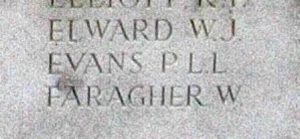Kerry is a village and community in Montgomeryshire, situated on the A489 road, almost three miles southeast of Newtown. The parish church, dedicated to St. Michael and All Angels, is of Norman origins, and caters for the rural community, which includes the villages of Kerry, Glanmule, Dolfor and Sarn. The men of the Parish who fell during both World Wars, fourteen in WW1 and two in WW2, are commemorated on the Parish War Memorial, which takes the form of a Celtic Cross, and is situated within the grounds of St. Michael’s Church. Oddly there are as many men of Kerry missing from the memorial as there are named on it, so I have taken the liberty of adding their details below, to ensure they are not forgotten.
The Great War, 1914-1918
Edward Ashton, Private, 1998, Welsh Guards. Edward was born at Kerry in 1876, the son of John and Catherine Ashton, of Cwmgwern. By 1901 he was living at Whittington, Shropshire, where he married Edith Austin in 1908, and the couple lived at 15, Babbins Wood, Whittington. Edward enlisted into the Welsh Guards in 1915, and was drafted out to France at some time early in 1916, joining the 1st Battalion, Welsh Guards. The Regiment had been raised by Royal Warrant of 26 February 1915, at White City, before landing at Le Havre on 18 August 1915, becoming attached to 3rd Guards Brigade, Guards Division. The Division saw its first major action during the Battle of Loos, which began on 25 September 1915, remaining in the area during the coming months, where they also fought in the subsequent Action of Hohenzollern Redoubt. Edward probably joined the battalion among a reinforcement draft early in 1916. In July 1916 the Division moved to the Somme, where it fought at the Battle of Flers-Courcelette, and then at the Battle of Morval, capturing Lesboeufs Village. The division remained here for the winter, and in March 1917 took part in the advance caused by the German Retreat to the Hindenburg Line. Later that year it moved north to Ypres and fought at the Battle of the Pilckem Ridge, the opening phase of the Passchendaele offensive. The Guards Division saw further fighting at Ypres, during the later stages of the offensive, before being moved south, taking part in the Battle of Cambrai and by the end of November was in the thick of the action. The Division saw heavy fighting during the German Spring offensive of March 1918, and again during the great offensive, which was launched by the Allies on 21 August 1918. Edward survived the war, but was discharged from the Welsh Guards as medically unfit on 9 February 1919, his health having deteriorated badly, and the couple moved to West Lodge, Fitz Manor, near Shrewsbury. He died of tuberculosis there on 11 April 1921, aged 45. Edward is not currently commemorated by the CWGC, although I have recently submitted his case to them. He is not commemorated on the Kerry war memorial.
Frederick Lloyd Bebb, Private, 3030, Royal Welsh Fusiliers. Frederick was the son of William Edward Bebb and Sarah Bebb, of Fronoleu, Kerry. He was a farm worker prior to the war. Frederick enlisted into the 7th Battalion, Royal Welsh Fusiliers at Newtown. The battalion was a Territorial unit, which mobilised for war at Newtown in August 1914, as part of North Wales Brigade, Welsh Division and moved to Conway until the end of the month, before moving to Northampton. Frederick died at Northampton on 30 October 1914, aged 19. The cause of his death is not specified in any papers which are available. His remains were brought home for burial in St. Michael’s Churchyard, Kerry. His brother, John, died of wounds at Ypres in 1916.
John Henry Bebb, Corporal, 443, Welsh Guards. John was the son of William Edward Bebb and Sarah Bebb, of Fronoleu, Kerry. He married Lucy Elizabeth Thomas in 1908 and the couple then moved to 22, York Place, Newport, Monmouthshire at some time prior to the war. John enlisted at Newport into the Grenadier Guards, but later transferred to the newly formed 1st Battalion, Welsh Guards. The Regiment had been raised by Royal Warrant of 26 February 1915, at White City, before landing at Le Havre on 18 August 1915, becoming attached to the 3rd Guards Brigade, Guards Division. The Division saw its first major action during the Battle of Loos, which began on 25 September 1915, remaining in the area during the coming months, where the Guards also fought in the subsequent Action of Hohenzollern Redoubt. The Guards Division then moved to the Laventie sector before going to the Calais area in February 1916, to rest. The Guards Division then transferred to the Ypres Salient in March 1916, taking over the line at Potijze. On 19 June the Welsh Guards moved into a new section of front line at La Belle Alliance, and found the condition of the trenches to be terrible. Defences were weak and the trenches were unsanitary, so the men began work trying to improve their new home. John was among a party of men wounded by shrapnel when a German shell crashed into the trench during the day. He was evacuated to the Hospital at Lijssenthoek, where he died of his wounds on 23 June 1916, aged 28. John is buried in Lijssenthoek Military Cemetery, Belgium. His brother, Frederick, had died in 1914.
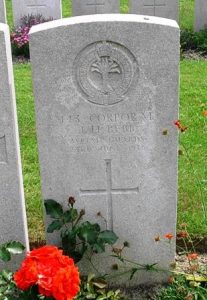
Albert Charles Brumwell, Private, 30582, East Lancashire Regiment. Albert was the son of Charles and Hannah Brumwell, of The Court Farm, Kerry. He enlisted into the Training Reserve at Welshpool and after completing his training was posted to France in the summer of 1917, joining the 11th Battalion, East Lancashire Regiment, which was attached to 94 Brigade, 31st Division. The Division had seen heavy fighting during the Battle of Arras during the Spring of 1917, and remained in the Arras sector, near Roclincourt and then Oppy, throughout the rest of the year. During February 1918 the British army was reorganised, with some infantry battalions being disbanded, due to lack of men, and as a result, others were moved around., and on 11 February 1918 the 11th East Lancs transferred to 92 Brigade, in the same 31st Division. At the beginning of 1918 the Division was in the line at Ecurie, still in the Arras sector. At dawn on 21 March 1918 the Germans launched their massive Spring offensive along the section of line running from Croisilles to La Fère, and the Division saw heavy fighting over the coming days as it was forced to withdraw back towards Essarts. The focus of the German offensive then switched north to the Lys valley, and the 31st Division moved north to help in the defence of Merville. The Division was hit by the Germans on 12 April and took part in another fierce fighting withdrawal over the coming days. The Germans then switched the focus of their offensive to the Champagne sector, along the Aisne, in May, and as a result the line to the north became relatively quiet. The 31st Division remained in Flanders over the summer, and its battalions carried out the usual routines of trench life. On the night of 15 August 1918, the 11th East Lancs moved back into the front line near Lamotte, to begin a routine four-day tour. The Germans in front had withdrawn, so during this spell the battalion advanced the line over 200 yards. Albert was killed in action here on 18 August 1918, just before his battalion was relieved. The 20-year-old is buried in Le Grand Hasard Military Cemetery, Morbecque, France.
Albert Edward Cleaton, Private, 498176, Labour Corps. Albert was born at Kerry in 1885, the son of John and Sarah Cleaton. He married Edith Susannah Stanbury on 5 January 1910, and the couple set up home at Glanafon Terrace, Newtown. By 1914 the family had moved to 10, Mackintosh Terrace, Nelson, Glam, where Albert worked as an underground colliery repairer. He enlisted at Trelewis into the Labour Corps on 10 December 1915, and was initially placed on the Army Reserve. Albert was mobilised on 7 January 1918 and posted to Park Hall Camp, Oswestry and was then posted to the 422nd Agricultural Company. In June 1918 he was transferred to the 532nd Agricultural Company, at Wrexham, and served with the company for the rest of the war. Albert was home on leave at Trelewis, when he suddenly died on 5 January 1919, aged 33. His remains were brought back to Kerry and he was buried with full military honours in St. Paul’s Churchyard, Dolfor. Albert is not commemorated on the Kerry war memorial. His son, John Bernard Stanbury Cleaton, was killed at sea in 1944.
George Charles Cross, Private, 25522, Grenadier Guards. George was the son of William and Elizabeth Cross, of Kerry. He worked as a grocer prior to the war. George enlisted at Manchester into the Grenadier Guards, and after completing his training, was posted to France early in 1916, joining the 2nd Battalion, Grenadier Guards. At the beginning of 1916 the battalion was in Flanders, attached to the 1st Guards Brigade, Guards Division, but in February moved with the Division into the Ypres Salient, to a camp at Poperinghe, before moving to reserve positions near Calais. On 18 March the Guards moved back into the Ypres Salient, taking over a section of front at Potijze, and the men spent the first weeks on improving the trenches, whilst carrying out the usual routines of trench rotation. At the end of July, the Guards Division moved out of the Salient, and entrained at Proven to begin the move south, to the Somme sector. The Guards took over a section of front line near Beaumont Hamel on 11 August, but soon moved slightly south and by 12 September moved via Bernafay Wood to Ginchy. The Guards Division then saw heavy fighting during the Battle of Flers-Courcelette, which was launched on 15 September, and saw the use of tanks for the first time. The 2nd Grenadiers then had a brief rest, before moving to the front line again, spending three days in wet, muddy shell-holes in Bernafay Wood before taking over the front line on 24 September, relieving the 2nd Coldstream Guards. On 25 September 1916 the Grenadiers attacked the village of Lesboeufs, suffering heavy casualties, and then came under heavy shell-fire before being counter-attacked. George was killed in action during the fighting that day, one of over 330 casualties suffered by his battalion. The 21-year-old has no known grave and is commemorated on the Thiepval Memorial, France.
Ellis Lawton Davies, Private, 56969, Welsh Regiment. Ellis was the son of Alfred and Mary Davies, of 5, Upper Hodley, Kerry. He worked as a waggoner at Vaynor Farm, Newtown prior to the war. Ellis enlisted into the Montgomeryshire Yeomanry at Welshpool on 17 January 1916, and was posted to the 3/1st Battalion, at Park Hall Camp, Oswestry, for training. On 8 August 1916 Ellis was drafted to France, joining No 5 Infantry Base Depot at Rouen and on 1 September 1916 he was posted to the 10th Battalion, Welsh Regiment, which was attached to 114 Brigade, 38th (Welsh) Division. The Division had taken over the Canal Bank sector at Boesinghe following its epic efforts in capturing Mametz Wood in July 1916. The infantry battalions of the Division then began carrying out the normal pattern of rotation in the trenches, four days in the front, four in support and four in reserve, whilst also working on trench improvement, digging new trenches, and also carrying out regular patrols and trench raids. The 10th Welsh, comprised mainly of miners from the Rhondda valley, was attached to the 177th Tunnelling Company, Royal Engineers, and was worked hard, building a series of underground bunkers and deep dugouts over the coming months. In May 1917 Ellis attended the Divisional Lewis Gun School, becoming a Machine-Gunner in the battalion. On 31 July 1917 the Division launched its famous assault on the Pilckem Ridge, capturing Iron Cross and reaching its objective of the Steenbeek, then played a supporting role in the Battle of Langemarck. On 5 September 1917, Ellis was with his battalion in the line facing Langemarck, when he was killed during an artillery barrage. The 24-year-old has no known grave and is commemorated on the Tyne Cot Memorial, Belgium.
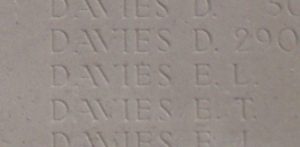
Noel Pryce Davies, Lance Corporal, G/24808, Queen’s Own (Royal West Kent Regiment). Noel was the son of John and Mary Davies, of Malt House, Sawmills, Kerry. He enlisted into the Welsh Horse Yeomanry in Newtown soon after the outbreak of war. The Welsh Horse had been the brainchild of Owen Roscomyl, a famed Welsh adventurer, and was raised in Cardiff as a Welsh cavalry regiment. Lord Kensington took command of the newly formed regiment, which trained in Sophia Gardens, Cardiff. HQ of the Welsh Horse then transferred to Newtown, while the regiment moved to join the 1/1st North Midland Mounted Brigade, 1st Mounted Division in the Diss area, in Norfolk. Noel did not embark for Gallipoli with the Welsh Horse in 1915, but remained in Norfolk with its reserve battalion. He was among a number of men of the Welsh Horse to be drafted to France to join the 7th Battalion, Queen’s Own (Royal West Kent Regiment), which was attached to 55 Brigade, 18th (Eastern) Division. The Division had landed at Boulogne on 25 May 1915, and moved to the Somme sector, taking part in the opening battles of the Somme offensive in July 1916. Noel probably joined the battalion on the Somme during the summer of 1916, where it had suffered heavy casualties as it fought throughout the Battle of the Somme. During March 1917 the Division followed the German Retreat to the Hindenburg Line, and in May took part in the Third Battle of the Scarpe, which was part of the Arras Offensive. July 1917 saw the Division at Ypres, where it took part in the Battle of Pilckem, helping to capture Westhoek. The Division then they fought at the Battle of Langemarck, and at the First Battle of Passchendaele, followed by the Second Battle of Passchendaele. Noel had survived all of these terrible battles, but was killed in action while the battalion was supplying working parties near Boesinghe on 26 November 1917. The 21-year-old is buried in Artillery Wood Cemetery, Belgium.
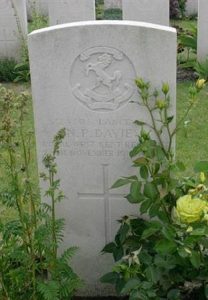
Stephen Davies, Private, 290774, Royal Welsh Fusiliers. Stephen was the son of Richard and Mary Jane Davies, of Sarn, Kerry. He worked as a farm labourer prior to enlisting into the 7th Battalion, Royal Welsh Fusiliers at Newtown on 27 October 1914. Stephen was posted to the 3/7th Battalion, Royal Welsh Fusiliers at Oswestry, and on 31 May 1916 embarked for Egypt, to join the 1/7th Battalion, Royal Welsh Fusiliers, which was attached to 158 Brigade, 53rd (Welsh) Division. The Division had been evacuated from Gallipoli in December 1915, moving to Egypt to join the EEF, and helped guard the Suez Canal before taking part in operations to drive the Turks out of the Sinai. The EEF then turned its attention onto driving the Turks out of Palestine, and on 26 March 1917 launched its first offensive against the coastal city of Gaza, which guarded the road to Jerusalem. Initial gains during the day were lost when the assaulting divisions lost touch with each other and communication broke down when a thick fog cloaked the battlefield. A second attempt to force Gaza was launched on 17 April, which also failed, and the EEF suffered a change in leadership, with Sir Edmund Allenby assuming command, before being re-organised, and a third offensive was launched against a wider front from Beersheba to Gaza on 31 October 1917. This time the Turkish defences were breached, and the road to Jerusalem now lay open and the EEF began to advance north. On 6 November 1917, 158 Brigade launched an attack on the Khuweilfeh Heights. Stephen was killed in action during the attack that day. The 22-year-old has no known grave and is commemorated on the Jerusalem Memorial, Israel. Stephen is not commemorated on the Kerry war memorial.
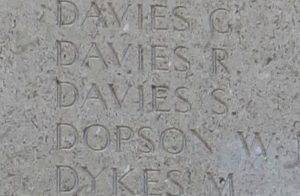
Pryce Evans, Private, 56976, Welsh Regiment. Pryce was the son of Robert and Elizabeth Evans, of Cwmsydawel, Kerry. He enlisted into the 3/1st Battalion, Montgomeryshire Yeomanry at Newtown on 11 December 1915 and was posted to Oswestry to join the battalion. After completing his training, Pryce embarked for France on 8 August 1916, and was posted to No 5 Infantry Base Depot at Rouen. On 1 September 1916 he was drafted to the 10th Battalion, Welsh Regiment, which was attached to 114 Brigade, 38th (Welsh) Division. The Division had taken over the Canal Bank sector at Boesinghe following its epic efforts in capturing Mametz Wood in July 1916. The infantry battalions of the Division then began carrying out the normal pattern of rotation in the trenches, four days in the front, four in support and four in reserve, whilst also working on trench improvement, digging new trenches, and also carrying out regular patrols and trench raids. The 10th Welsh, comprised mainly of miners from the Rhondda valley, was attached to the 177th Tunnelling Company, Royal Engineers, and was worked hard, building a series of underground bunkers and deep dugouts over the coming months. On 25 January 1917 the 10th Welsh relieved the 13th Welsh in the front-line trenches, to begin another routine tour. Pryce was killed in action here on the following day, 26 January 1917. The 29-year-old is buried in Bard Cottage Cemetery, Belgium. Pryce is not commemorated on the Kerry war memorial.
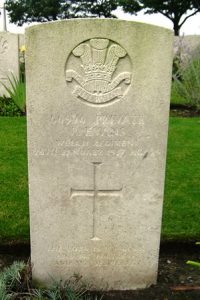
William Richard Evans, Private, 2513, Montgomeryshire Yeomanry. William was the son of Richard and Mary Jane Evans, of Boot Cottage, Kerry. He enlisted at Welshpool into the 2/1st Battalion, Montgomeryshire Yeomanry, and was posted to Huntingdon, where the battalion was attached to the 2/1st Eastern Mounted Brigade. William had not been in uniform long when he took ill, and was sent home. He died at Kerry soon afterwards, on 4 March 1915, aged 20. William was buried in St. Michael’s Churchyard, Kerry. There is one William R. Evans commemorated on the Kerry war memorial, but two men from the village of that name, so it could be either.
William Richard Evans, Private, 55282, Royal Welsh Fusiliers. William was the son of Edward and Elizabeth Evans, of Holly Bush, Sarn, Kerry. He worked as a Grocer at Newtown prior to the war. William enlisted at Newtown into the 7th Battalion, Royal Welsh Fusiliers, and after completing his training was drafted to France at some time in the winter of 1916-17, joining the 13th Battalion, Royal Welsh Fusiliers, which was attached to 113 Brigade, 38th (Welsh) Division. The Division was in position in the Canal Bank sector at Boesinghe when William joined its ranks. The infantry battalions of the Division were carrying out the normal pattern of rotation in the trenches, four days in the front, four in support and four in reserve, whilst also working on trench improvement, digging new trenches, and also carrying out regular patrols and trench raids. On 31 July 1917 the Division launched its famous assault on the Pilckem Ridge, capturing Iron Cross and reaching its objective of the Steenbeek, then played a supporting role in the Battle of Langemarck. The Division was transferred to the Sailly-sur-la-Lys sector in September, and remained in the area over the winter before being moved to positions north of Albert, at Bouzincourt Ridge, at the end of March 1918, relieving the battered 2nd and 47th Divisions. It held this sector, again carrying out minor operations and trench raids, over the coming months, before taking part in the great offensive of 21 August 1918, and began its advance towards the Hindenburg Line. The 13th RWF launched its part of the Divisions assault two days later, on 23 August, reaching its assembly point at the railway cutting east of Albert at 01.45. The battalion advanced at 04.55, attacking on a frontage of 2,000 yards, with its objectives running from a line from Crucifix Corner, Aveluy, to the Albert to Bapaume Road. The men took their objectives, despite heavy resistance, capturing two field guns, 16 machine-guns, 150 prisoners and countless supplies, but had suffered the loss of one officer and twenty other ranks killed, five officers and 117 other ranks wounded. Nineteen men were missing. William was among those killed in action during the day. The 36-year-old is buried in Bapaume Post Military Cemetery, Albert, France. There is one William R. Evans commemorated on the Kerry war memorial, but two men of the village of that name, so it could be either.
Henry Griffiths, Private, M2/021890, Army Service Corps. Henry was born in Kerry in 1891, the son of William and Margaret Griffiths. He worked as a Chauffeur at White House, Leighton by 1911 and then as a Motor Lorry Driver at Altrincham prior to the war. Henry enlisted into the Army Service Corps, Motor Transport, at London on 12 December 1914 and was posted to the No 1 Reserve MT Depot at Grove Park for his training. Henry then appears to have been attached to the Explosives Loading Company, a munitions works, at Faversham. He was badly injured when the factory was rocked by a massive explosion on 2 April 1916. On 28 April 1916 Henry was discharged from the Army Service Corps as unfit, due to his injuries, and he was sent to a hospital at Gloucester, where he died of his injuries on 26 September 1916, aged 25. His remains were brought home for burial in St. Michael’s Churchyard, Kerry. A brother, James, had been killed in France just a month earlier. Neither brother is commemorated on the Kerry war memorial.
James Noel Griffiths, Private, 34692, South Wales Borderers. James was born at Kerry in 1893, the son of William and Margaret Griffiths. The family had moved to The Nook, Dunham Town, Altrincham by 1911, where William worked as a woodman. James worked as a labourer prior to enlisting at Stockport into the 3rd Battalion, Cheshire Regiment on 5 February 1916 and was posted to the Barracks at Chester before joining the battalion at Birkenhead. James embarked for France on 20 July 1916, joining No 4 Infantry Base Depot at Rouen, and on 21 July 1916 was posted to the 9th Battalion, Cheshire Regiment, which was on the Somme attached to 58 Brigade, 19th (Western) Division. He was then among a number of drafts for the battalion to be attached to the 1st Battalion, South Wales Borderers, which was also on the Somme attached to 3 Brigade, 1st Division. James joined the battalion at Millencourt, where it was resting and reorganising after heavy fighting at Bazentin Ridge and High Wood. After almost three weeks rest, the 1st Division moved back into the line between Bazentin-le-Petit Wood and High Wood on 15 August and the 1st SWB took over positions in reserve in Becourt Wood. On 20 August the 3rd Brigade took over the Divisional front line and the 1st SWB took up positions in OG1, an Old German trench running North and South due west of Bazentin-le-Petit Wood. The battalion suffered several barrages of mixed artillery and gas shells over the following days. On 24 August 1916 the 2nd Munster’s launched an attack on the Brigade front, but suffered heavily, so the 1st SWB was ordered forwards to support them. James was killed by artillery fire during the day. The 23-year-old has no known grave and is commemorated on the Thiepval Memorial, France. A brother, Henry, died of accidental injuries suffering whilst serving with the ASC a month later. Neither brother is commemorated on the Kerry war memorial.
Henry Edward Hooper, Private, 36042, Royal Warwickshire Regiment. Henry was the son of Henry and Fanny Cooper, of Dolforgan Lodge, Kerry. He enlisted into the Training Reserve at Welshpool, and was then posted to the Cheshire Regiment for training. After embarking for France, Henry was posted to the 16th Battalion, Royal Warwickshire Regiment, which was attached to 15 Brigade, 5th Division. The Division had returned to France from Italy on 8 April 1918, to help reinforce the beleaguered army on the Western Front, due to the heavy losses suffered following the German Spring offensive of 21 March. The Division took over positions near Telegraph Hill, south of Arras, but soon afterwards was rushed north, as the Germans had launched the second phase of their offensive along the Lys, and the Division entrained for the area of Merville, which was under attack, relieving the battered 47th Division and digging a new defensive line to defend the Nieppe Forest. On 21 April the new line was bombarded with gas shell, but no further action followed, and the 16th Warwick’s were relieved, going back into reserve, as the Germans had now focused their efforts to the south in the Aisne sector. During the summer the Division remained in the line, but on 14 August was withdrawn for a rest, before taking part in the great offensive, which was launched by the Allies on 21 August. The 5th Division launched its part of the advance from Bucquoy, in the Somme sector, taking Achiet-le-Grand that day as the Division pushed slowly towards the Hindenburg Line. On 27 September 1918 the 16th Warwick’s launched an assault on the Hindenburg Line outer defences, but were counter-attacked by a German bombing party. Harry was killed in action during the heavy fighting which followed that day. The 19-year-old has no known grave and is commemorated on the Vis-en-Artois Memorial, Haucourt, France.
Cornelius Pryce Jones, Gunner, 108230, Royal Field Artillery. Cornelius was the son of Albert Edward Jones and Ann Jones, of Cwmberllan, Sarn. He married Martha Annie Griffiths, of Lower Pennygelly, Kerry in 1916. Cornelius enlisted into the Royal Field Artillery in Newtown, and after completing his training was posted to France, joining the 29th Division Ammunition Column, Royal Field Artillery. The Division was a very experienced unit, having fought at Gallipoli in 1915 and throughout the Somme offensive of 1916. Cornelius probably joined the Division early in 1917, soon after his marriage. The Division followed the German withdrawal to the Hindenburg Line in March 1917, before being relieved from the Somme sector and had a brief rest before moving to the Arras sector, where it took part in the Battle of Arras, suffering heavy casualties around Monchy-le-Preux. The Division then moved north to the Ypres Salient at the end of June, and trained ready to take part in the Passchendaele offensive, which was launched on 31 July 1917. The 29th Division moved into the Langemarck sector, taking over positions which had been hard won by the 38th (Welsh) Division during the opening days of the offensive, and suffered terribly in the Flanders mud. Cornelius was wounded towards the end of September, possibly during a barrage of gas shell that hit the Division whilst it was in reserve positions. He was evacuated to the 61st Casualty Clearing Station, Belgium, where he died of his wounds on 2 October 1917, aged 27. He is buried in Dozinghem Military Cemetery, Belgium. Cornelius is not commemorated on the Kerry war memorial.
John Edward Jones, Private, 83290, Welsh Regiment. John was born in Kerry in 1900, the son of Pryce Jones and Mary Jones. The family later resided at the Elms Inn, Newtown. John worked as a Drapers Assistant prior to enlisting into the 53rd (Young Soldier’s) Battalion, Welsh Regiment at Welshpool on 19 November 1917. John then spent two months on the Army Reserve before being mobilised on 22 January 1918 and sent to Kinmel Park to join the battalion for training. On 20 July 1918 John was posted to the 3rd Battalion, Welsh Regiment, before embarking for France on 26 August 1918, joining No 5 Infantry Base Depot, and on 30 August joined the 14th Battalion, Welsh Regiment, which was attached to 114 Brigade, 38th (Welsh) Division. The Division was near Morval, having launched its part of the great Allied offensive from the Aveluy Wood sector on 21 August 1918, and had crossed the old Somme battlefields of the 1916 offensive during the previous days. John would have joined the battalion after its assault on Morval on 1 September, probably while it was holding trenches near Sailly-Saillisel. Three days later the 14th Welsh famously forced the crossing of the Canal du Nord at Manancourt, allowing the rest of the Division to cross. The 14th Welsh then went into reserve to rest and train, before coming back into the line on 17 September in readiness to assault Gouzeaucourt. On 18 September 1918 the Division launched an assault on the Gouzeaucourt defences, and the 14th Welsh, in conjunction with 114 Brigade, captured Heather Trench. John was killed in action during the fighting that day. The 18-year-old has no known grave and is commemorated on the Vis-en-Artois Memorial, Haucourt, France. John is not commemorated on the Kerry war memorial.
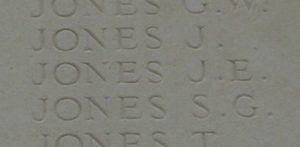
Richard Walter Jones, Private, 202955, Welsh Regiment. Richard was the son of Walter and Elizabeth Jones, of Cilthrew, Kerry. He enlisted at Newtown into the Training Reserve, and after completing his training, was posted to France in the summer of 1917, joining the 17th Battalion, Welsh Regiment, which was attached to 119 Brigade, 40th (Bantam) Division. The Division was formed from Bantam units, comprising of men who were under the usual height for military service, and had been in France since June 1916, seeing its first major actions during the end of the Somme offensive, during the Battle of the Ancre that year. The Division followed the German withdrawal to the Hindenburg Line in March 1917, and had a relatively peaceful time holding the Gouzeaucourt and Gonnelieu sectors over the coming months, broken only by the incessant routines of trench rotation. The Division then went out of the line to train and prepare for the forthcoming Battle of Cambrai, and moved to the launching off point for their assault on Bourlon Wood by 22 November. On the following day, 23 November 1917, the 40th Division launched its assault on Bourlon Wood, a massive wood which lies to the north of the Arras to Cambrai Road. The 17th Welsh was in support for the assault of 119 Brigade, while the 19th RWF and 12th SWB attacked the wood, supported by a number of tanks. On the evening of 22 November, the 17th Welsh had moved forward from Doignies, spending the night in a sunken road, and just before midday moved into the wood to support the assault. Richard was killed in action in the wood during heavy fighting on 25 November 1917. The 19-year-old has no known grave and is commemorated on the Cambrai Memorial, Louverval, France.
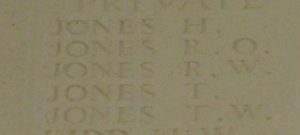
Ernest Edward Longman, Private, 290274, Royal Welsh Fusiliers. Ernest was the son of William and Laura Longman, of Little Perthybu, Sarn. He worked as a farm labourer prior to enlisting at Newtown into the 7th Battalion, Royal Welsh Fusiliers on 13 August 1914. The battalion was a Territorial unit, which mobilised for war at Newtown in August 1914, as part of North Wales Brigade, Welsh Division and moved to Conway until the end of the month, before moving to Northampton. In December the Division moved to Cambridge and then in May 1915 to Bedford, where the Division was numbered and the formation became 158 Brigade, 53rd (Welsh) Division. On 19 July 1915 the entire Division sailed from Devonport for Imbros and on 9 August 1915 landed at Suvla Bay. Ernest did not embark with the battalion, but remained at Bedford with its reserve battalion. The Division was eventually evacuated from Gallipoli in December 1915, moving to Egypt to join the EEF, and helped guard the Suez Canal before taking part in operations to drive the Turks out of the Sinai. Ernest embarked at Southampton for Egypt on 11 December 1916, and after disembarking joined the 1/7th Battalion, Royal Welsh Fusiliers on the Suez Canal defences. The EEF then turned its attention onto driving the Turks out of Palestine, and on 26 March 1917 launched its first offensive against the coastal city of Gaza, which guarded the road to Jerusalem. Initial gains during the day were lost when the assaulting divisions lost touch with each other and communication broke down when a thick fog cloaked the battlefield. Ernest was posted as missing believed killed in action during the fighting that day, 26 March 1917. No trace of the 19-year-old was ever found, so he is commemorated on the Jerusalem Memorial, Israel. Ernest is not commemorated on the Kerry war memorial.
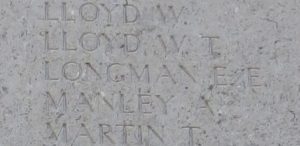
John Herbert Morgan, Sergeant, 235846, Royal Welsh Fusiliers. John was the son of John and Elizabeth Morgan, of Red House, Kerry. He enlisted into the Montgomeryshire Yeomanry at Welshpool on 20 October 1914 and was posted to the 2/1st Battalion, Montgomeryshire Yeomanry, which had just been formed. In July 1915 the battalion moved to Dorchester to join the 2/1st South Wales Mounted Brigade and in September 1915 moved to Southwold, the brigade joining the 1st Mounted Division. John remained on home service with the battalion for most of the war, moving to Thorndon Park, Brentwood in July 1916, and then to Worlingham and Gorleston. He was drafted to France on 21 October 1918, joining the 16th Battalion, Royal Welsh Fusiliers, which was attached to 113 Brigade, 38th (Welsh) Division. The Division had been advancing from its positions north of Albert during the previous months, as part of the great Allied offensive, and had crossed the Canal du Nord and the mighty Hindenburg Line. John joined the battalion in the field, at Berlaimont, on 6 November, just five days before the Armistice. On the following day the battalion marched to Aulnoye, and at dawn on 8 November launched its final assault of the war, against strong German defences in the Forest of Mormal. John was wounded during the assault of 8 November and evacuated to No 12 General Hospital, Rouen, where he died of his wounds on 21 November 1918. The 25-year-old is buried in St. Sever Cemetery Extension, Rouen, France.
Richard Morgan, Company Sergeant Major, 242326, Labour Corps. Richard was the son of Richard and Elizabeth Morgan, of Kerry. He joined the 24th Regiment, South Wales Borderers as a young man, and whilst based in Ireland married Annie Luidsie on 11 January 1894, bringing his wife back to live in Kerry by 1901, by which time he was a Staff Sergeant with the 1st Battalion, South Wales Borderers. Richard retired from the regiment after 21 years of service and by 1911 the family was residing at 75, Barlow Lane, Walton Road, Liverpool, where Richard had found work as a caretaker. Following the outbreak of war, he felt the compulsion to re-enlist into his old regiment, and on 4 September 1914 attested at Liverpool. A man of his experience would have been much appreciated to help train new recruits, and he was posted to the Depot at Brecon before joining the 9th (Reserve) Battalion at Kinmel Park. Richard was then posted to the 57th Training Reserve Battalion at Kinmel Park upon its formation in 1917. On 28 July 1917 he was transferred to the 376th Home Employment Company, Labour Corps, and on 6 August 1918 joined the 560th Home Service Employment Company. Richard was still serving with the Company after the Armistice, but took ill in the summer of 1919 and died of heart disease at the Royal Infirmary, Liverpool on 1 July 1919. The 52-year-old is buried in Anfield Cemetery, Liverpool. Richard is not commemorated on the Kerry war memorial.
John Cecil Morris, Private, 3249, Royal Welsh Fusiliers. John, known as Cecil, was the son of William and Elizabeth Morris, of Kerry. He worked as a cowman prior to enlisting into the 7th Battalion, Royal Welsh Fusiliers at Newtown soon after the outbreak of war. The battalion was a Territorial unit, which mobilised for war at Newtown in August 1914, as part of North Wales Brigade, Welsh Division and moved to Conway until the end of the month, before moving to Northampton. In December the Division moved to Cambridge and then in May 1915 to Bedford, where the Division was numbered and the formation became 158 Brigade, 53rd (Welsh) Division. On 19 July 1915 the entire Division sailed from Devonport for Imbros and on 9 August 1915 landed at Suvla Bay. The infantry moved off the beaches into the bush, but due to a lack of maps and no knowledge of the terrain, many of the units became disorientated, and the situation became chaotic. John was killed in action on the following day, 10 August 1915. The 21-year-old has no known grave and is commemorated on the Helles Memorial, Gallipoli.
Richard Octavius Newell, Private, 291868, Welsh Regiment. Richard was born in Kerry in 1898, the son of Francis Thomas and Jane Newell. The family later lived at Barmouth Junction, Arthog, where Francis had become Station Master. Richard worked as a Booking Clerk for the Cambrian Railways at Barmouth Station prior to the war, and married Dorothy Alice Davies, of Chirk, in 1917. He had already enlisted into the army, and when he was posted to France joined the 1/6th Battalion, Welsh Regiment, which was the Pioneer battalion to the 1st Division. He probably joined the battalion after the closure of the Passchendaele offensive. The Division was near Éstaires when the second phase of the German Spring Offensive hit on 9 April 1918 and saw heavy fighting during its withdrawal towards Bethune. It was then moved to Arras, and from there took part in the great offensive which was launched on 21 August 1918, seeing action at the Battle of Drocourt-Queant, and at the Battle of Épehy, whilst driving towards the St. Quentin Canal, and then moved towards the Hindenburg Line. Richard was accidentally killed at Berthaucourt, north-west of St. Quentin, on 1 October 1918. The 20-year-old was buried by his comrades in Berthaucourt Communal Cemetery, Pontru, France. He is commemorated on the Arthog war memorial and the Cambrian Railways Memorial at Oswestry, but not on the Kerry war memorial.
Cyril Gordon Phillips, Second Lieutenant, South Wales Borderers. Cyril was the son of the Reverend Thomas and Mrs. Clara Anne Phillips, The Moat, Kerry. Cyril was educated at Llandovery College between 1907 and 1910, and was commissioned into the 3rd Battalion, South Wales Borderers on the 8th June, 1915. On the 30th August, 1916 he arrived on the Somme, to join ‘A’ Company, 1st Battalion, South Wales Borderers. The Battalion was attached to 3 Brigade, 1st Division. Cyril saw his first action during the Battalion’s support of the Gloucester’s in an attack on High Wood. The Battalion remained on the Somme for the duration of the Battles there in 1916, and they followed the German retreat to the Hindenburg Line in early 1917. The Division was then briefed for an operation on the Flanders Coast, and moved there during the Summer of 1917. While training on the coast, the Battle of Third Ypres had stalled in the mire, and the Division were recalled to Ypres, where they fought at the Second Battle of Passchendaele. During the Battle of Passchendaele, Cyril’s Battalion found themselves at Goudberg Spur, northwest of Passchendaele Village. In atrocious weather, the Battalion attacked the strategic strongholds known as ‘Virtue’ ‘Virile’, ‘Vocation’ and ‘Void’. It was during these attacks that Cyril was killed in action on 10 November 1917. He was 25 years old, and has no known grave, and so is commemorated on the Tyne Cot Memorial, Passchendaele, Belgium.
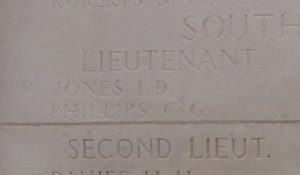
Herbert Evans Price, Private, 38614, King’s Shropshire Light Infantry. Herbert was born in Kerry in 1899, the son of John Smith Price and Annie Price (nee Evans). By 1911 the family had moved to Derlwyn House, Llanfyllin. Herbert enlisted at Llanfyllin into the Training Reserve, and after completing his training was posted out to France at some time in 1918, joining the 7th Battalion, King’s Shropshire Light Infantry, which was attached to 76 Brigade, 3rd Division. The Division had been caught up in desperate fighting following the launching of the German Spring offensives, taking part in the initial fighting of 21 March and suffered heavy casualties before being moved to Flanders to rest, becoming caught up in the second phase of the German offensive on the Lys from 9 April onwards. The Division remained in the Locon sector after the fighting had moved south, to the Aisne sector, in May, enjoying a relatively peaceful time over the coming months. Herbert would have arrived at some time during this more peaceful period. By August 1918 the Division was in position in the Arras sector, ready to take part in the great Allied offensive, which was launched on 21 August. The 7th KSLI assembled at Monchy au Bois on 20 August, and the following morning launched their part of the great advance, taking Courcelles during the day. The battalion was counter-attacked on the following day, but beat the Germans off. On 23 August the 7th KSLI launched an attack against a series of strong-points along the railway embankment east of Courcelles. Herbert was killed in action during the fighting that day. The 18-year-old has no known grave and is commemorated on the Vis-en-Artois Memorial, Haucourt, France. Herbert is not commemorated on the Kerry war memorial.
Thomas William Pryce, Private, 164856, Machine Gun Corps. Thomas was the son of Thomas and Louisa Pryce, of Glanmeheli, Kerry. At some time prior to the war, he had moved to Lobb Farm, Great Haseley, Oxfordshire. Thomas enlisted at Warwick into the Warwickshire Yeomanry, and was probably initially posted to the 2/2nd Battalion at Fakenham. He then embarked for Egypt and served in Egypt and Palestine with the 1/1st Battalion, Warwickshire Yeomanry later in the war. During the summer of 1918 the battalion merged with the South Nottinghamshire Hussars to for the 100th Battalion, Machine Gun Corps. On 26 May 1918 the battalion sailed from Alexandria aboard the SS Leasowe Castle, but on the following day the ship was torpedoed and sunk with a loss of 15 officers and 78 other ranks. The survivors returned to Egypt and sailed again from Alexandria, landing at Taranto on 21 June before entraining for Étaples and remained there until 25 August when it entrained at Étaples to join the Fourth Army which had just launched its offensive towards the Hindenburg Line from the Somme sector. By 6 September the 100th MGC had reached positions west of Nurlu, catching up the advancing army, and saw its first action at Épehy, during the breaking of the Hindenburg Line outer defences on 18 September. On 21 September 1918 Thomas was in action again with his gun crew when the Germans shelled their position, and he was killed. The 23-year-old is buried in Épehy Wood Farm Cemetery, Épehy, France. Thomas is not commemorated on the Kerry war memorial.
William Richard Pryce, Private, 290831, Royal Welsh Fusiliers. William was the son of Edward and Mary Pryce, of Old Hale Cottage, Sarn. He worked as a farm servant prior to enlisting into the 7th Battalion, Royal Welsh Fusiliers at Newtown on 12 November 1914. The battalion was a Territorial unit, which mobilised for war at Newtown in August 1914, as part of North Wales Brigade, Welsh Division and moved to Conway until the end of the month, before moving to Northampton. In December the Division moved to Cambridge and then in May 1915 to Bedford, where the Division was numbered and the formation became 158 Brigade, 53rd (Welsh) Division. On 19 July 1915 the entire Division sailed from Devonport for Imbros and on 9 August 1915 landed at Suvla Bay. The infantry moved off the beaches into the bush, but due to a lack of maps and no knowledge of the terrain, many of the units became disorientated, and the situation became chaotic. William was killed in action during the fighting that day. The 25-year-old is buried in Gaza War Cemetery, Israel.
Reginald Ernest Pryce-Jones, Lieutenant, Canadian Infantry. Reginald, known as Rex, was born at Kerry on 13 October 1896, the only child of Colonel Albert Westhead Pryce-Jones, OBE, and Mrs Rosina Ida Pryce-Jones (nee Gibson), and was the grandson of Sir Pryce Pryce-Jones, of the Royal Welsh Warehouse in Newtown. Rex moved to Canada with his parents in 1910 to set up the Canadian branch of the family business, the Pryce-Jones Department Store. Rex enlisted into the 103rd Calgary Rifles, a Militia unit, on his eighteenth birthday, on 13 October 1914 and on 2 January 1915 was commissioned into the 50th Battalion, Canadian Infantry. On 27 October 1915 he embarked for England with the battalion, and upon its arrival the battalion entrained for Bramshott. Reginald took ill in May 1916, and suffered a short spell in hospital suffering from bronchial catarrh. He re-joined the battalion as soon as he had recovered and embarked for France with the battalion on 11 August 1916. The battalion moved to the Somme sector, as part of the 10th Canadian Brigade, 4th Canadian Division, to join the Canadian Corps and moved to the Courcelette area. On 14 November the 50th Battalion moved into the front line at Regina Trench, and three days later volunteers were sought to go over the top and assault the German lines, some 200 yards in front. Rex was among the volunteers who went over the top, following an artillery barrage, on 18 November 1916, but was killed when the men became exposed to enfilade machine-gun and artillery fire. His body was recovered and carried back to Albert two days later, and the 20-year-old was buried in Albert Communal Cemetery Extension, France. Ernest was posthumously Mentioned in Despatches in the London Gazette of 1 June 1917. He is not commemorated on the Kerry war memorial.
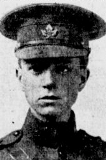
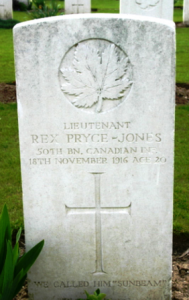
William Reynolds, Private, 6635, Royal Welsh Fusiliers. William is a bit of a mystery. He was born in Kerry, and had a brother John, and two sisters, Mary and Sarah, but had enlisted into the Royal Welsh Fusiliers under the name of Frank Owen. He had most likely enlisted some time before the war, and was also quite possibly of an advanced age, as he was posted to the 2nd (Garrison) Battalion, Royal Welsh Fusiliers, which had embarked for garrison duties in Egypt from Devonport on 6 March 1916. William served in Egypt for almost two years before his health broke down, and he died of pneumonia at Sollum on 5 March 1918. He is buried in Alexandria (Hadra) War Memorial Cemetery, Egypt. William is not commemorated on the Kerry war memorial.
Rowland Ellis Richards, Private, 71539, Sherwood Foresters. Rowland was born at Kerry in 1894, the son of Samuel and Sarah Ann Richards. By 1901 the family had moved away, and set up home at Cross Head Farm, Colwich, Staffordshire. Rowland worked on his parent’s farm prior to enlisting at Rugeley into the North Staffordshire Regiment during the summer of 1916. After embarking for France, he was transferred to the 16th Battalion, Sherwood Foresters (Notts and Derby Regiment), which was attached to 117 Brigade, 39th Division. The battalion had seen much fighting during the Somme offensive in 1916, and on 17 November had entrained from Gézaincourt for Flanders, and enjoyed a brief rest before moving into the Ypres Salient, taking over positions on the Canal Bank near Chateau des Trois Tours. In January 1917 the Division took over the Railway Wood sector, and its infantry battalions began the regular routines of trench rotation. The Division remained at Ypres over the coming months, and on 31 July 1917 took part in the opening assault of the Third Battle of Ypres, the Battle of Pilckem Ridge. After some fierce fighting, the Division went into reserve for a short rest, before moving back into the front line at the Shrewsbury Forest sector, and took part in another series of attacks, as part of the Battle of the Menin Road. Rowland was killed during a German counter-attack on 22 September 1917. The 22-year-old was originally buried on the battlefield, but in 1919 his grave was exhumed and identified by his ID disc, before he was re-buried in Perth Cemetery (China Wall), Belgium. Rowland is not commemorated on the Kerry war memorial.
Charles Joseph Roberts, Private, 285137, Monmouthshire Regiment. Charles was the son of Charles and Elizabeth Roberts, of Llwyncorwid, Kerry. He worked as a farm labourer prior to enlisting at Newtown into the 7th Battalion, Royal Welsh Fusiliers on 31 October 1914. The battalion was a Territorial unit, which mobilised for war at Newtown in August 1914, as part of North Wales Brigade, Welsh Division and moved to Conway until the end of the month, before moving to Northampton. In December the Division moved to Cambridge and then in May 1915 to Bedford, where the Division was numbered and the formation became 158 Brigade, 53rd (Welsh) Division. On 19 July 1915 the entire Division sailed from Devonport for Imbros and on 9 August 1915 landed at Suvla Bay. The infantry moved off the beaches into the bush, but due to a lack of maps and no knowledge of the terrain, many of the units became disorientated, and the situation became chaotic. Charles survived the initial carnage of the coming days, but was wounded in October, and was evacuated to Hospital in Mudros, before returning to England aboard the Hospital Ship Aquitania. He married Annie Elizabeth Powell, of Newtown, whilst home on leave in the autumn of 1916, and their daughter, Lilian, was born on 25 May 1917. After recovering fully, Charles embarked at Southampton for France on 13 June 1917, joining the Infantry Base Depot at Rouen, and was then transferred to the 2nd Battalion, Monmouthshire Regiment. The regiment had a close affiliation with the South Wales Borderers, so on 24 June Charles was attached to the 2nd Battalion, South Wales Borderers, which was attached to 87 Brigade, 29th Division. The Division had suffered heavy losses during the Battle of Arras that spring, before being rebuilt and transferred to the Ypres Salient at the end of June 1917. The Third Battle of Ypres opened on 31 July 1917, and the 38th (Welsh) Division had advanced and taken over the line along the Steenbeek, south of Langemarck. On 15 August the 2nd SWB moved forwards into this position, and at dawn on 16 August 1917 launched an assault from the Steenbeek towards Langemarck. Charles was killed in action during the terrible fighting which followed that day. The 29-year-old has no known grave and is commemorated on the Tyne Cot Memorial, Belgium.
Samuel Harold Thomas, Private, 54434, Royal Welsh Fusiliers. Samuel, known as Harold, was the son of Pryce and Alice Thomas, of Rhiewdantin, Kerry. He enlisted at Welshpool into the Montgomeryshire Yeomanry, but after completing his training, was among 133 men of the Denbighshire and Montgomeryshire Yeomanry who were transferred to the 10th Battalion, Royal Welsh Fusiliers, which was attached to 76 Brigade, 3rd Division, and joined the battalion at Morlancourt on 21 August 1916. The battalion had seen intense fighting on the Somme, gaining a fine reputation for its work in Delville Wood, where two men of the battalion gained the award of the Victoria Cross. The entire Division had by now been relieved and was resting and rebuilding behind the lines. At the end of August, the Division moved to the Loos sector, near Noeux-les-Mines, and moved into the Loos trenches for a short spell. On 23 September the Division began to march back to the Somme sector in stages, reaching Bertrancourt by 9 October, and the Division moved back into the front line soon after. On 12 November orders were received by the Division for an assault on the strongly defended ruins of Serre, and on 13 November 1916 the 10th RWF launched their part of the assault. The initial assault went well, but the 10th RWF found that they had advanced beyond both flanking battalions, and suffered terrible casualties, with well over 300 men killed, wounded or missing. Harold had been wounded and taken prisoner by the Germans, and died in captivity on 18 November 1916, aged 19. He was buried in Ecourt St. Quentin German Cemetery. In 1920 his grave was exhumed, and Harold was re-buried in Vis-En-Artois British Cemetery, Haucourt, France.
John Goodwin Webster, Private, 55538, Royal Welsh Fusiliers. John was the son of William and Elizabeth Webster, of Llancowrid, Sarn. He enlisted at Welshpool into the Montgomeryshire Yeomanry, and was among a large draft of men of the Montgomeryshire Yeomanry posted out to France and transferred to the 17th Battalion, Royal Welsh Fusiliers in the Spring of 1917. The battalion was in the Canal Bank sector at Boesinghe, attached to 115 Brigade, 38th (Welsh) Division, and was carrying out the normal pattern of rotation in the trenches, four days in the front, four in support and four in reserve, whilst also working on trench improvement, digging new trenches, and also carrying out regular patrols and trench raids. On 31 July 1917 the Division launched its famous assault on the Pilckem Ridge, capturing Iron Cross and reaching its objective of the Steenbeek, then played a supporting role in the Battle of Langemarck. The Division was transferred to the Sailly-sur-la-Lys sector in September, and remained in the area over the winter before being moved to positions north of Albert, at Bouzincourt Ridge, at the end of March 1918, relieving the battered 2nd and 47th Divisions. It held this sector, again carrying out minor operations and trench raids, over the coming months, before taking part in the great offensive of 21 August 1918, and began its advance towards the Hindenburg Line. The 17th RWF was in reserve on the first days, but crossed the Ancre on 23 August and advanced in conjunction with the 2nd RWF along the northern edge of Mametz Wood, continuing to advance over the coming days before resting on 31 August. On the following day, 1 September 1918, the Division attacked the village of Morval from the direction of Lesboeufs, capturing the village before reaching Sailly-Saillisel. John was killed in action during the day. The 27-year-old is buried in Blighty Valley Cemetery, Authille Wood, France. John is not commemorated on the Kerry war memorial.
John Herbert Williams, Private, 37086, Royal Welsh Fusiliers. John was the son of James and Mary Williams, of the Post Office, Sarn. He married Mabel Edwards, of Llangollen, on 5 December 1900, and the couple lived at 1, Bank Cottage, Broad Street, Newtown. Mabel died in 1915, and John went to live at 41, Egerton Road, Whitchurch, Shropshire, where he worked as a horse driver. He enlisted at Whitchurch into the 3rd Battalion, Royal Welsh Fusiliers on 18 November 1915 and was posted to Wrexham before being sent to the battalion at Litherland Camp, Liverpool for training. On 25 April 1916 John embarked at Southampton for France aboard the SS Copenhagen and upon arrival joined No 2 Infantry Base Depot at Rouen. He suffered a bout of measles soon after arriving, and was hospitalised for a short time before being posted to the 2nd Battalion, Royal Welsh Fusiliers on 5 July 1916. John joined the battalion in the line at Givenchy on 6 July, along with Captain Robert Graves and ten other men. The battalion was attached to 19 Brigade, 33rd Division, and had been undergoing a torrid spell in the Givenchy sector. On 8 July the Division was relieved and began to move to the Somme sector, to take part in the great offensive. By 16 July the 2nd RWF were bivouacked in the newly captured Mametz Wood, and moved to Bazentin-le-Petit two days later, to take part in the assault on High Wood. The battalion suffered heavy casualties at High Wood, and moved back into reserve at Buire-sur-L’Ancre until 6 August and then spent several days at Becordel before moving back into the line at High Wood on 18 August, and helped beat off a German counter-attack. John was wounded around this time, and spent a month in hospital. The Division remained on the Somme for the remainder of the offensive, wintering in the sector before following the German withdrawal to the Hindenburg Line in March 1917, and in April and May 1917 saw heavy fighting on the Hindenburg Line, as part of the Battle of Arras. The Division withdrew from Arras in July and moved to the Flanders coast, to prepare for a possible offensive, but when the Passchendaele offensive got bogged down in the Flanders mud, the Division was rushed into the Ypres Salient in the middle of September. On 26 and 27 September the 2nd RWF took part in desperate fighting for Polygon Wood, before moving into reserve to rest and rebuild. On 19 October 1917 the battalion was in Ypres, supplying working parties to assist the Royal Engineers in road building, when one party came under shellfire, killing John and six other men. John was probably one of four men posted as missing, believed to have been blown up by a direct hit. The 31-year-old has no known grave and is commemorated on the Tyne Cot Memorial, Belgium. John is not commemorated on the Kerry war memorial.
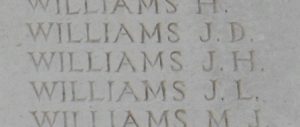
World War Two, 1939-1945
John Francis Andrew, Flight Sergeant, 1199065, Royal Air Force Volunteer Reserve. John was the son of John Thomas Andrew and Ethel Jane Andrew (nee Francis), of Abermule. He enlisted into the Royal Air Force Volunteer Reserve, and trained as a flight engineer before being posted to 426 (Royal Canadian Air Force) Squadron. The Squadron had formed at RAF Dishforth, Yorkshire, on 15 October 1942 as the RCAF’s 24th Bomber squadron, and was initially equipped with the Vickers Wellington bomber, moving to RAF Linton-on-Ouse on 18 June 1943. On 9 September 1944, John took off from Linton-on-Ouse aboard Vickers Wellington, NP681, but soon after take-off, the fully bomb-laden aircraft suffered an engine fire whilst flying over Wallingford, in Oxfordshire. Most of the crew bailed out, but John and his pilot, John Archibald Wilding, remained in the cockpit, to steer the doomed aircraft away from the town, and it crashed into fields nearby, killing both men. John was 23 years old, and his remains were brought home for burial in Kerry Cemetery. He was posthumously Mentioned in Despatches for his gallant self-sacrifice. Both men are commemorated by a memorial at the junction of Wilding Road and Andrew Road in Wallingford.
John Burton Stanbury Cleaton, Able Seaman, D/JX 266737, Royal Navy. John was born on 28 September 1911, the son of Albert and Alice Cleaton, of Kerry. He married Mary Blodwen Bennett in 1935. John enlisted into the Royal Navy following the outbreak of war and was posted to HMS President III, a RN depot in London. John was posted to the SS Brackenfield at some time in 1944. Brackenfield was a cargo steamer, owned by the Zillah Shipping & Carrying Co. On 10 June 1944, four days after D-Day, Brackenfield left the Isle of Wight assembly point with the SS Dungrange, loaded with a cargo of munitions, bound for Juno Beach. Whilst some 50 miles south of the Nab lighthouse, Brackenfield was attacked and sunk by a fleet of German E-Boats. John was 32-years-old when he was killed in the sinking, and is commemorated on the Plymouth Naval Memorial, Devon. His father, Albert, had died in 1919 as a result of his wartime service. John is not commemorated on the Kerry war memorial.
Percy Llewellyn Leonard Evans, Sapper, 4194872, Royal Engineers. Percy was the son of John Evans and Hannah Evans (nee Austin), of Kerry. He enlisted into the Royal Engineers and was posted to the 159th Railway Construction Company, RE. He was in France with the BEF in 1940. Following the German Blitzkrieg, the various elements of the BEF, as well as countless civilians, had been forced to withdraw to the French coast for evacuation. The thousands of troops who had made it to Dunkirk had already been evacuated by 6 June, whilst more had been evacuated from Boulogne, Calais and Le Havre by 25 May. More Allied troops had managed to reach ports in other parts of France, stretching from Cherbourg down to Bayonne, so the British organised Operation Aerial, to evacuate Allied forces and civilians from western France. Percy had managed to reach St. Nazaire with most of his company. On 17 June 1940 the requisitioned RMS Lancastria steamed into the Loire Estuary and anchored in the Charpentier Sounds. By the afternoon Lancastria had taken aboard a huge number of evacuees, far greater than she was built to carry, with estimates running from 4,000 to 9,000 people. The Germans had already begun attacking shipping in the area, and at 15.50 Lancastria was attacked by Junkers-88 bombers and sank in less than 20 minutes. An estimated 6,500 people drowned in the sinking of Lancastria that day. Percy was 26-years-old when he was lost in the sinking of the Lancastria. He has no known grave and is commemorated on the Dunkirk Memorial, France.
